- Joined
- Jan 6, 2013
- Messages
- 5,645
- Reaction score
- 11,331
1. The History
Brynkir Hall is located in the Cwm Pennant Valley, just North of Criccieth in North Wales. The origins of Brynkir can be traced all the way back to a thirteenth-century deer park, associated with the royal court or llys of Llywelyn the Great (1172-1240). The name ‘Brynkir’ itself is derived from Bryn Ceirw, meaning “hill of the deer”. It had previously appeared in documents and poetry in various other forms including Bryncir, Brynker, Bryncyr and Brynceirw.
The owners of the estate, the Brynkir family, had some interesting dynastic origins which can be traced all the way back to Owen Gwynedd. Building work started on the Brynkir estate in back in 1644 with the original hall, known as the “upper house”. It was built into the slope of a hillside, running parallel to the valley, so the gable ends faced the prevailing winds from Cwm Pennant. This afforded it strategic views over great distances while having protection from the elements. The house was much altered over the years and when the Brynker family died-out in the late 1700s, the estate was sold, the seventeenth-century additions to the hall removed circa 1800, and the upper house demoted to a farmhouse. Records indicate that the upper house continued in use into the mid-nineteenth century.
In the 1809, the 12,000-acre Brynkir Estate was bought by Captain Joseph Huddart (1741-1816). Huddart was a bit of a polymath: influential English Captain, hydrographer, chart-maker, inventor (including the steam-driven machinery for binding rope from which he made his fortune) and entrepreneur. He wanted to provide his family with a seat in north Wales and so went about using artisan craftsmen and a provincial architect to build a Regency villa. These are the ruins that remain today (sometimes referred to the ‘lower house’). The site was prepared for construction in late 1809 shortly after purchase and the walls raised in 1811. The first reference to the new house can be found in an estate account beginning in May 1812 and ends in December 1814. Here the records carefully detail all the purchases made as part of the house’s construction. Hence, we know by July 1812, the villa had been slated, and the interiors were in the process of being plastered. They also indicate that the house was likely to have been finished by December 1813. Surrounding the house were two serpentine walks through pleasure grounds, a small (now silted-up) lake and a large walled garden.
Sadly, after only seven years on the estate, Huddart died in 1816 and the estate passed to his son, also named Joseph. Born in 1767, he lived at the house with his wife and nine children between 1812 until his death in 1841. Sir Joseph held office as the high sheriff of Caernarfonshire, but also made his mark on the estate too. He oversaw the construction of one of the most interesting buildings on the estate: a six-story Gothic tower built on a nearby hill. In 1821 Joseph heard that the newly crowned monarch, George IV, was visiting North Wales. Prudently, he decided to celebrate the occasion by building the aforementioned folly. The tower was built using labour from ex-soldiers from the Napoleonic Wars who were part of a scheme to provide work for them. The tower certainly impressed as the king knighted Joseph Huddart during the visit.
The estate, in turn, then passed to his eldest surviving son, George Huddart (1822-1885). While his dad probably did the most work on the lower house, George made his mark by heightening the banqueting tower and possibly added a new frontage and entrance hall. He probably needed the room with his ten children! On his death, the eldest of his children, also named George Huddart (1845-1908), became the final Huddart to be lord of the manor. He commenced major building work on Brynkir in 1889, including the refurbishment of the interior and building a new porch and Billiard Room. This was incurred at significant cost (reportedly a sum of £8,000) and it nearly bankrupted the family.
Floor plan of Brynkir © Mark Baker
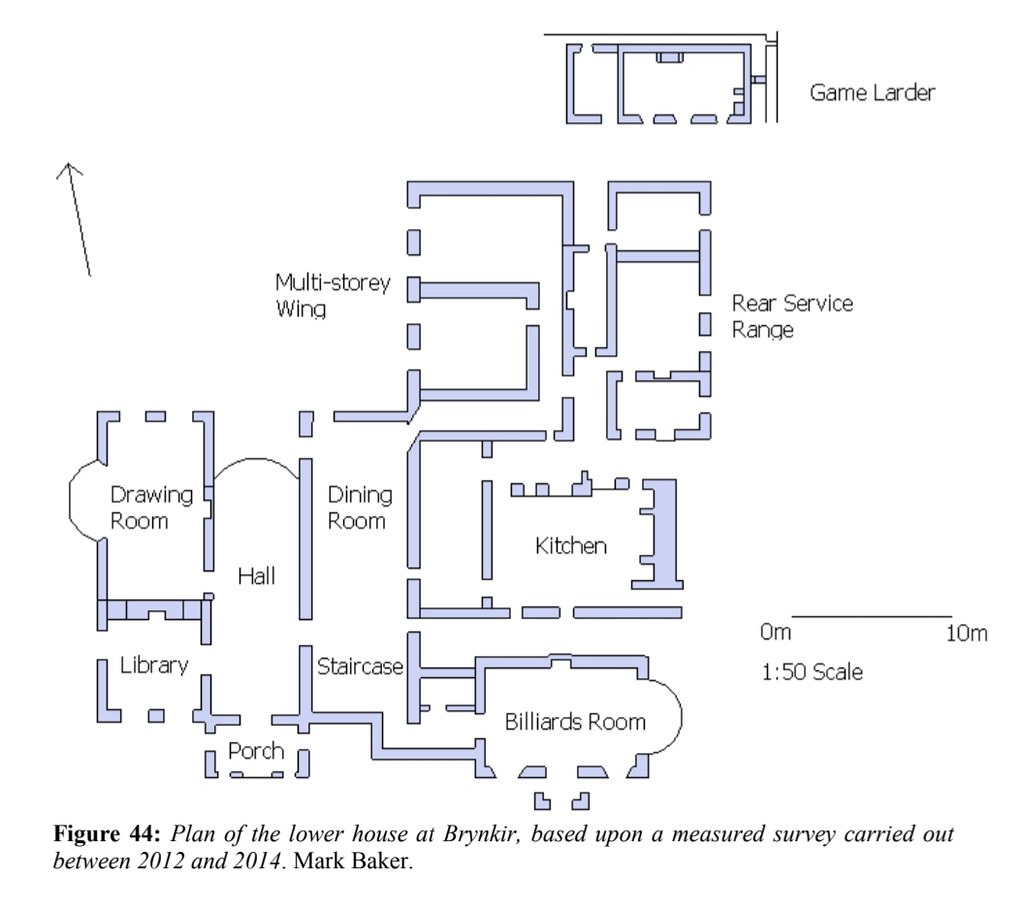 20200409_131903 by HughieDW, on Flickr
20200409_131903 by HughieDW, on Flickr
Artist’s impression of what the Brynkir would have looked like circa 1900 © Ceri Leeder.
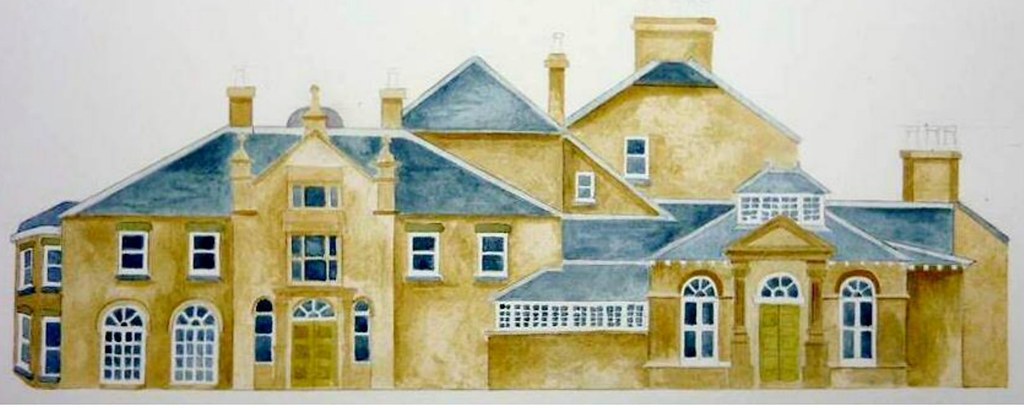 20200409_131942 by HughieDW, on Flickr
20200409_131942 by HughieDW, on Flickr
A clue to how the hall came to be vacant is recorded in Sir Clough Williams-Ellis’s (the creator Portmeirion) autobiography. In it he refers to his Uncle Dick telling him that as a boy, he’d had gone up to Brynkir, only to find the place completely deserted with the table laid for breakfast but left with eggs half eaten and teacups half full. At first it was thought one of George’s sons had run off with the family governess and everyone had left the house in hot pursuit. More recently, it was speculated that George Huddart had a secret family and when it was discovered by his wife, Elinor, a furious row ensued resulting in the house emptying. The couple never divorced but George moved to London and his wife to Sussex. Whatever the reason, what is certain is that the estate was sold off in 1903. The estate was bought by the Greave family who used it as a hunting lodge until the start of the First World War. It was then commandeered by the Ministry of Works as a POW Camp for around fifty German Officers. In April 1930 the estate was broken up and sold off in lots. The hall again lay empty and after the second world war the house was partially demolished with the remains left to further fell into ruin. Records indicate the house was the sold on to local farmers who stripped of any reusable building materials (principally timbers and metals) in late 1945.
The house pictured in 1950 (©Mason, G. Bernard) looking like a ruin already:
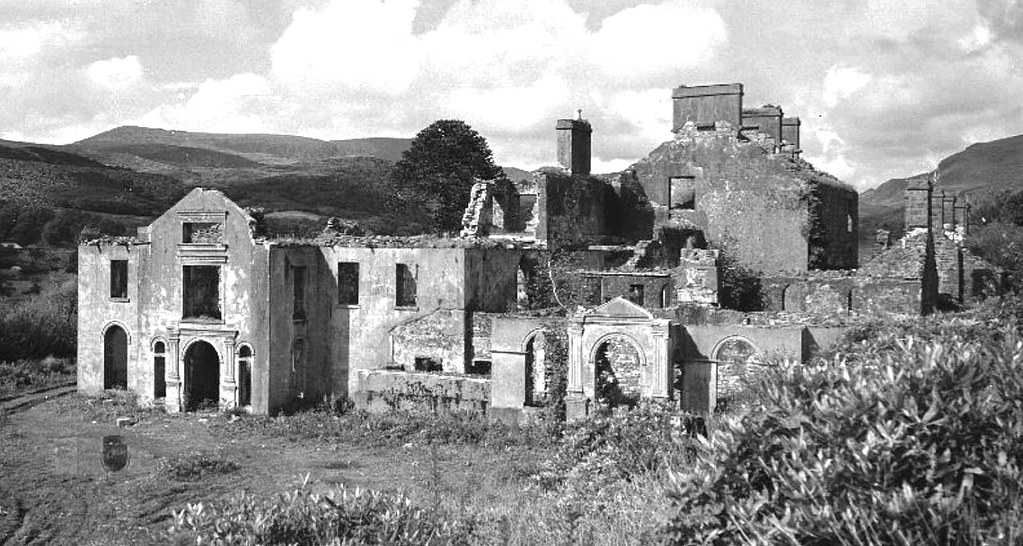 Bryncir old by HughieDW, on Flickr
Bryncir old by HughieDW, on Flickr
Since then, Tower has fared much better than the house itself. For many years a shell of four walls, in the early 1990s the folly was full-renovated and now provides superior holiday home accommodation. The site of the halls have been the subject of a number of recent archaeological digs between 2012-14 which turned up remnants of a dinner service and wine bottles bearing the family crest and the name of the house.
Reference: information and some illustrations were sourced from Mark Baker’s excellent PhD thesis: The Development of the Welsh Country House: your court, the soul of the land’ (2015).
2. The Explore
Really emotional return to this place. One of the first places I explored as a child with my dad back in the day, so it has a really special place in my heart. Haven’t been here for over twenty years or so it was nice to see the place again and get some digital photos of the place. Situated at the head of the beautiful Cwm Pennant valley, this place isn’t visible from Google Earth and you need to know where the place is. This plus the fact that the ruins are a bit out of-the-way explains why this enchanting place gets very little traffic. Spent a very enjoyable early July morning navigating the foliage and scrambling over the stones to try and capture what is left of this once great welsh house.
The ruins are now really given over to nature. They’re not spectacular as say the better-known Baron Hill Mansion but what they lack in the wow factor they make up for in the atmospheric stakes. They are now really overgrown and although getting to them isn’t such an issue it is hard to physically get around them and as such, hard to photograph both from a perspective point of view and the light situation.
One thing I didn’t do was go up the nearby hill to look at the tower which has faired much better than the hall. This is now been fully refurbished and provides high-end holiday accommodation.
3. The Pictures
Having scrambled down the bank this is the first of many arched doorways I came to. This one is from the former billiards room:
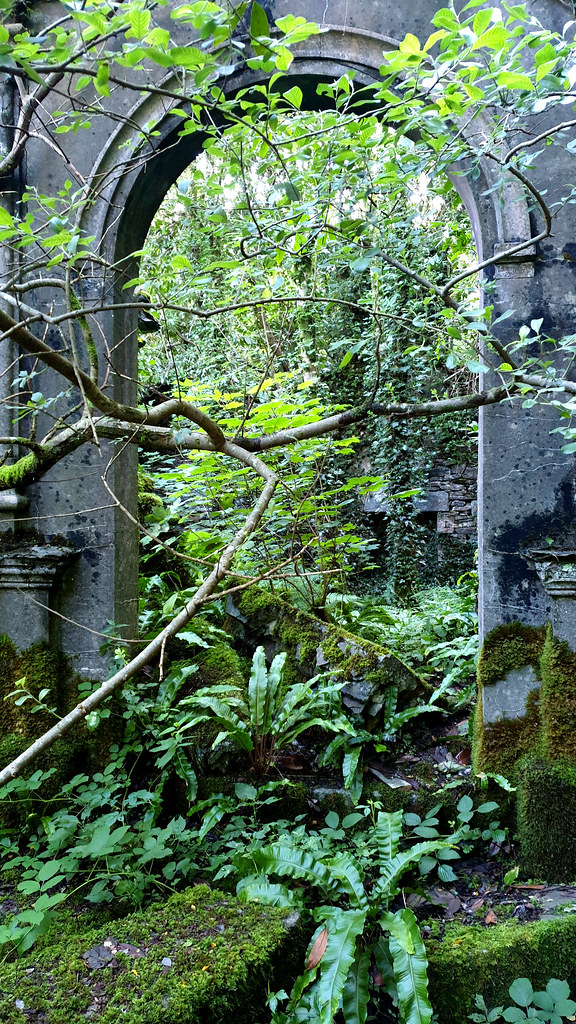 Bryncir 02 by HughieDW, on Flickr
Bryncir 02 by HughieDW, on Flickr
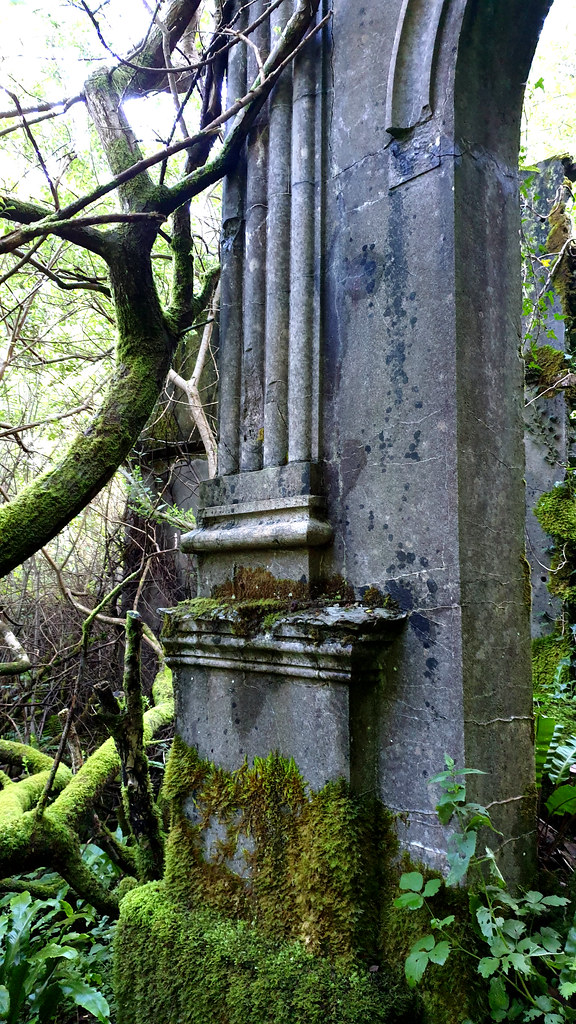 Bryncir 03 by HughieDW, on Flickr
Bryncir 03 by HughieDW, on Flickr
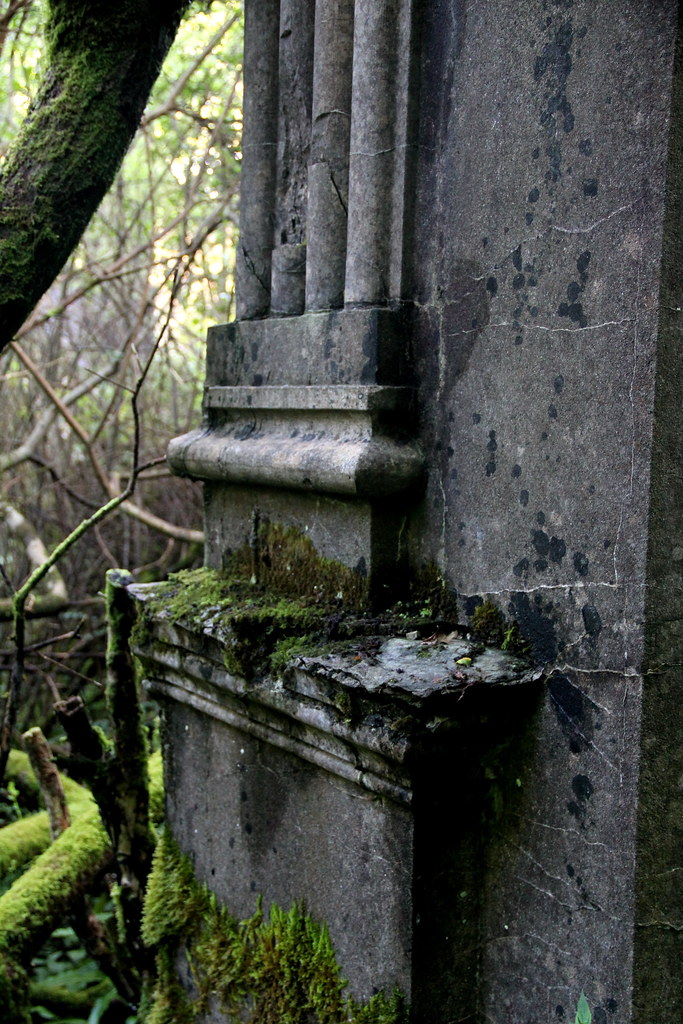 img7131 by HughieDW, on Flickr
img7131 by HughieDW, on Flickr
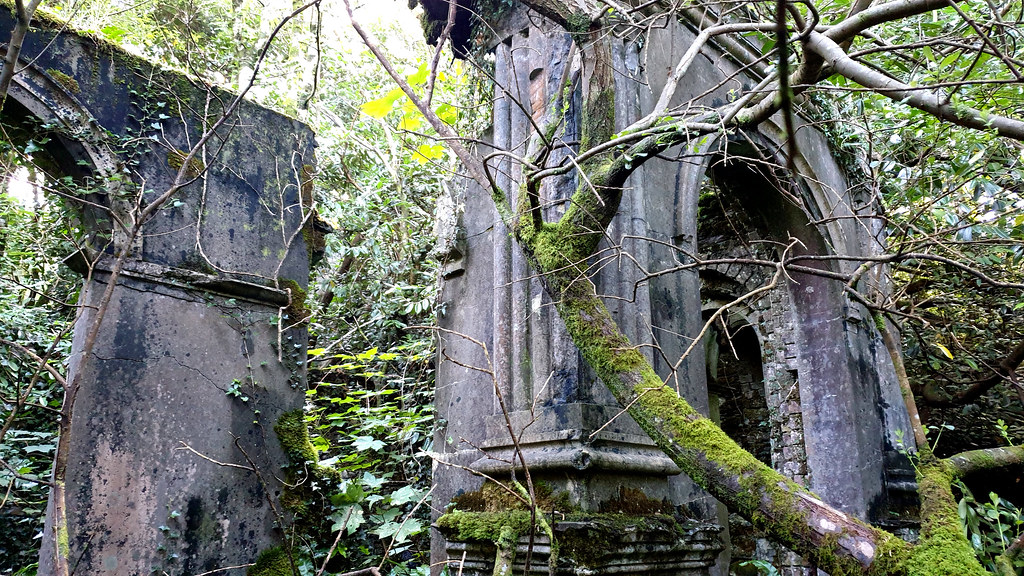 Bryncir 05 by HughieDW, on Flickr
Bryncir 05 by HughieDW, on Flickr
This part, the front porch, almost maintains its original height:
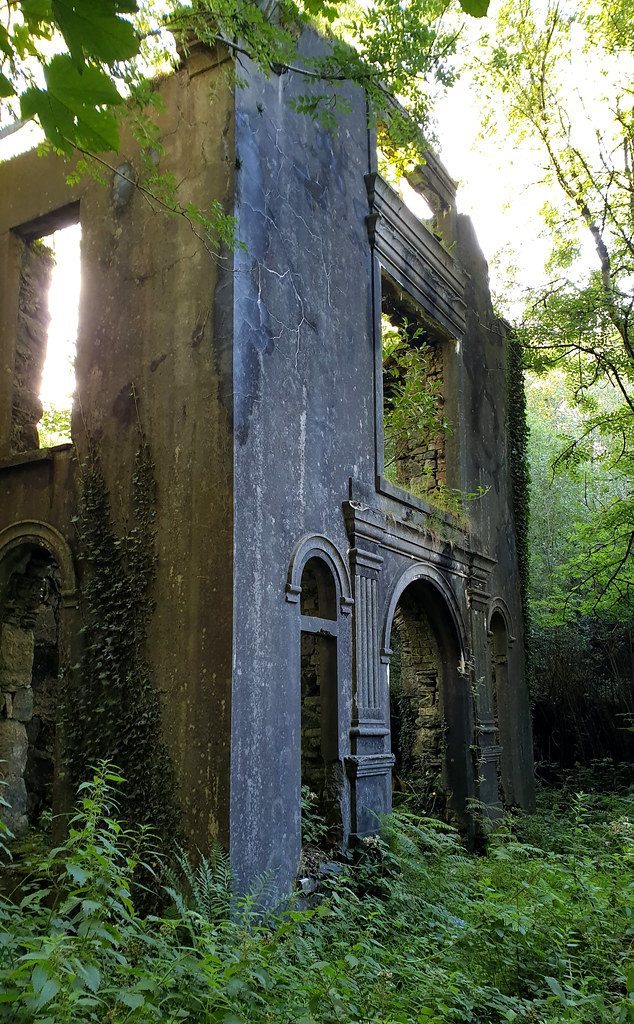 Bryncir 06 by HughieDW, on Flickr
Bryncir 06 by HughieDW, on Flickr
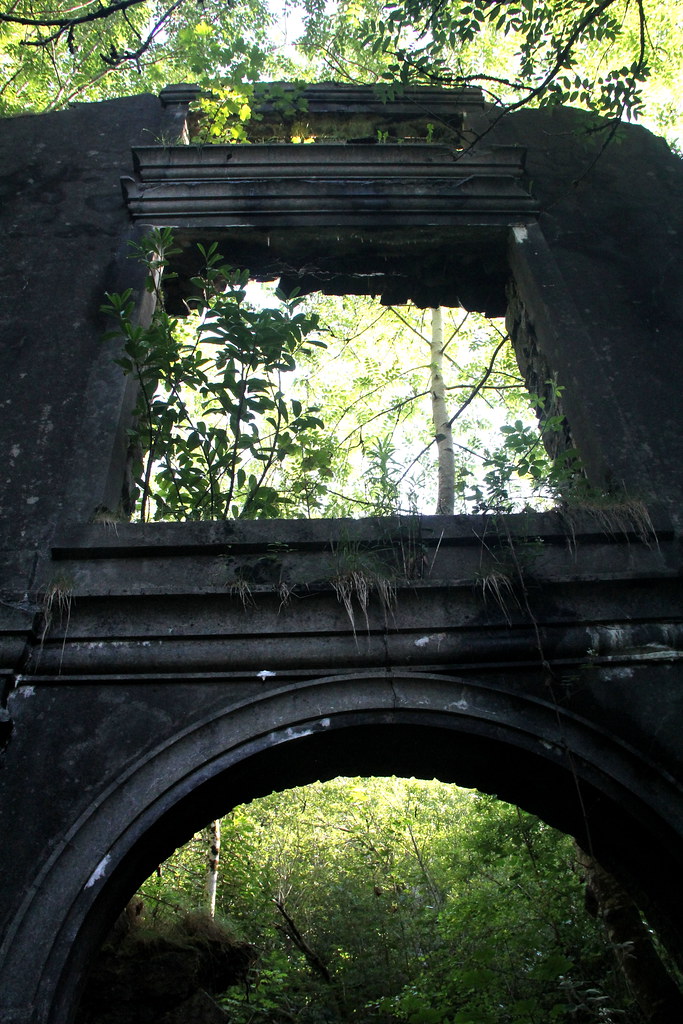 img7132 by HughieDW, on Flickr
img7132 by HughieDW, on Flickr
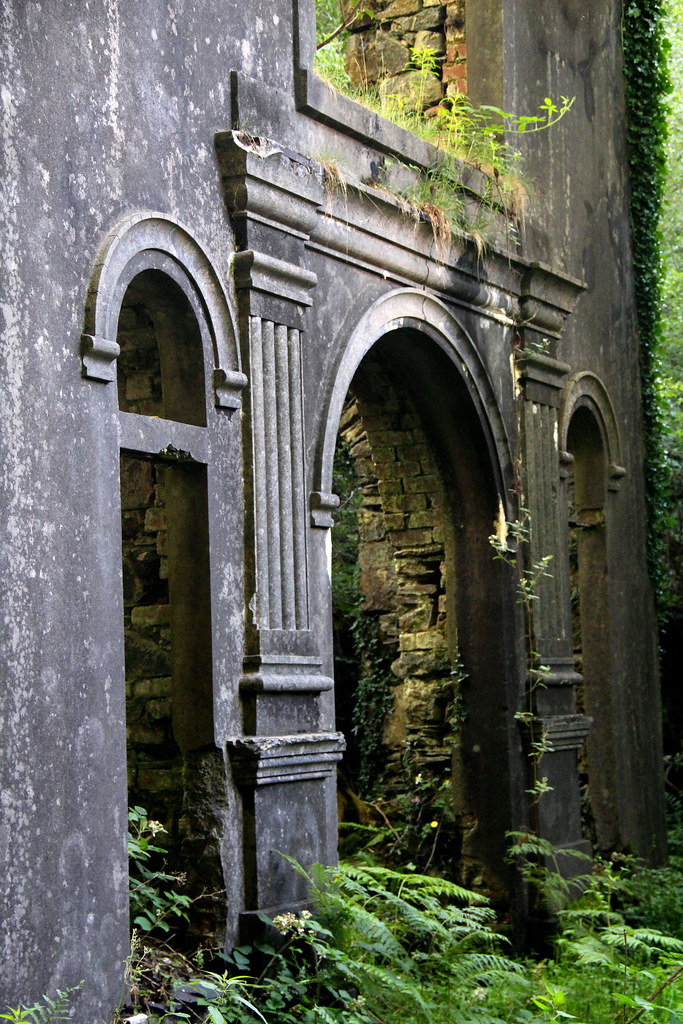 img7134 by HughieDW, on Flickr
img7134 by HughieDW, on Flickr
 Bryncir 07 by HughieDW, on Flickr
Bryncir 07 by HughieDW, on Flickr
Round to the curved bays of the side of the house and the former drawing room:
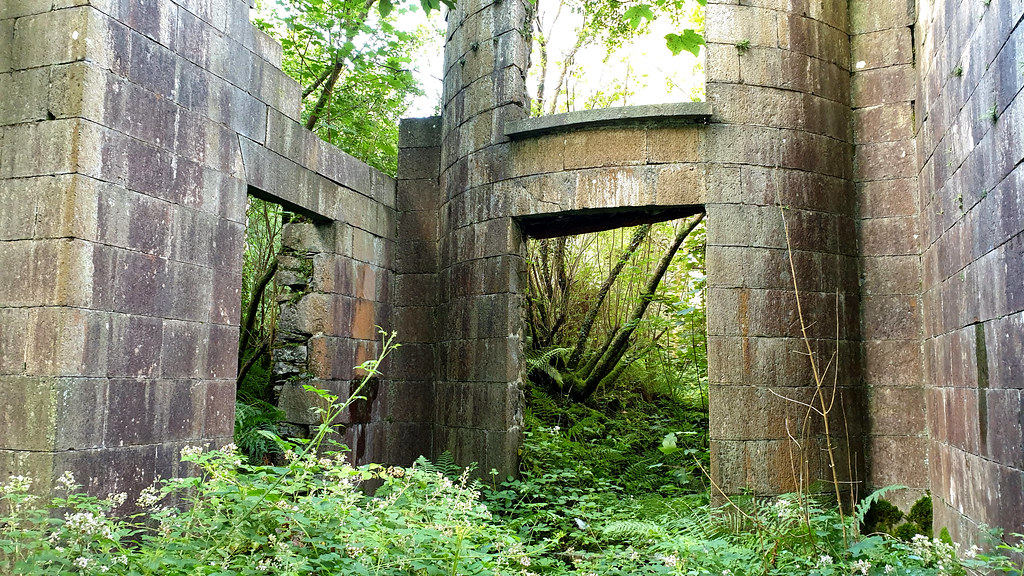 Bryncir 08 by HughieDW, on Flickr
Bryncir 08 by HughieDW, on Flickr
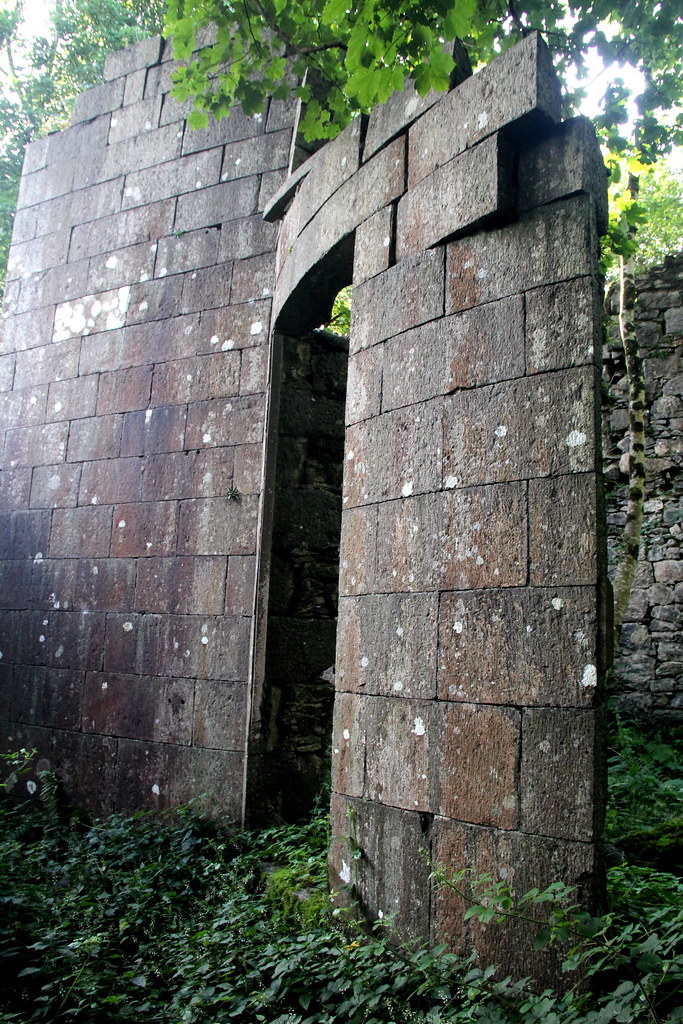 img7137 by HughieDW, on Flickr
img7137 by HughieDW, on Flickr
Some the building looks like bits will drop down at any minute:
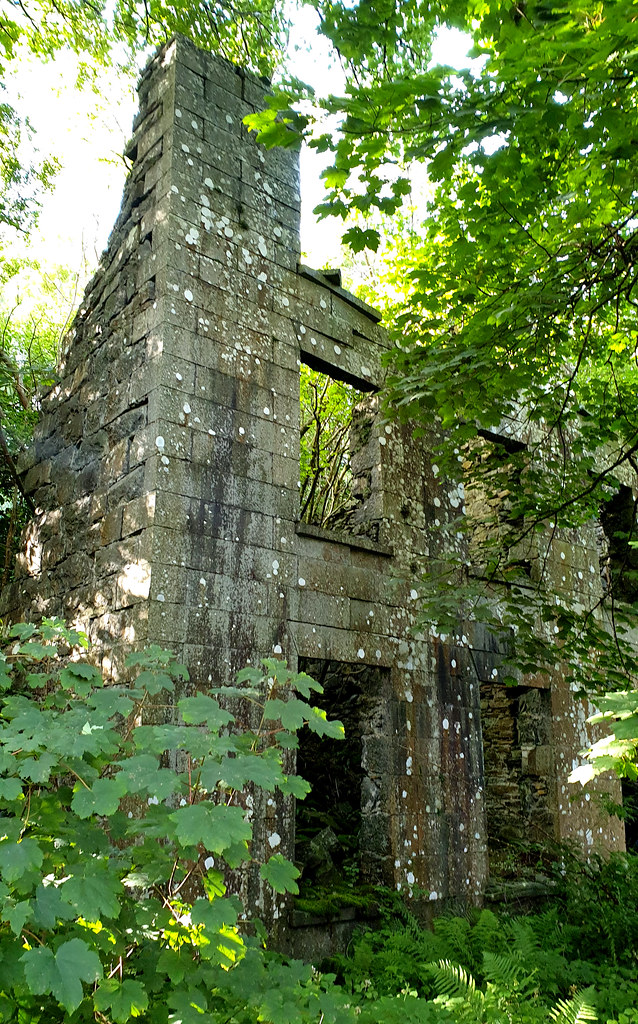 Bryncir 09 by HughieDW, on Flickr
Bryncir 09 by HughieDW, on Flickr
Inside it is completely overgrown:
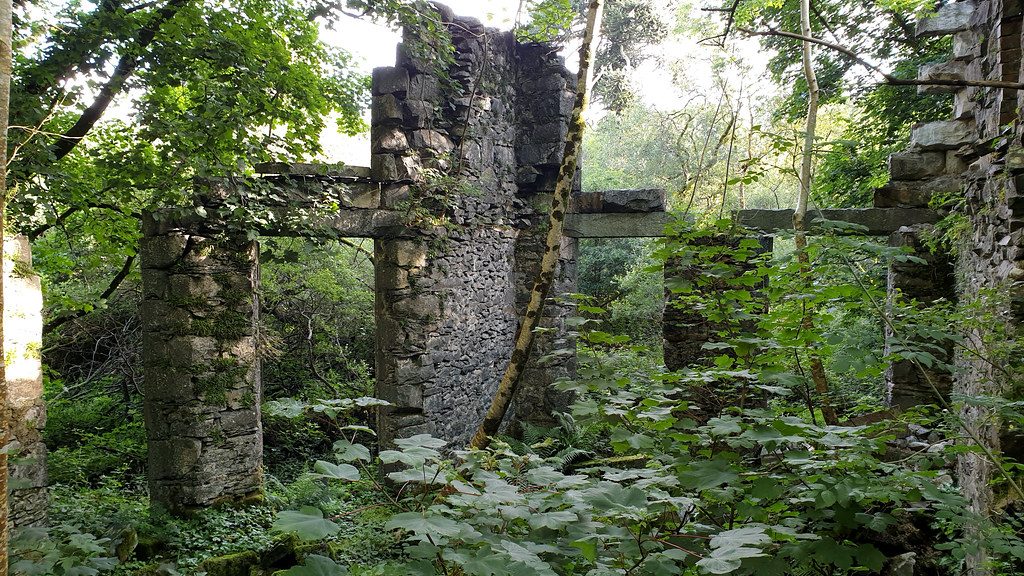 Bryncir 10 by HughieDW, on Flickr
Bryncir 10 by HughieDW, on Flickr
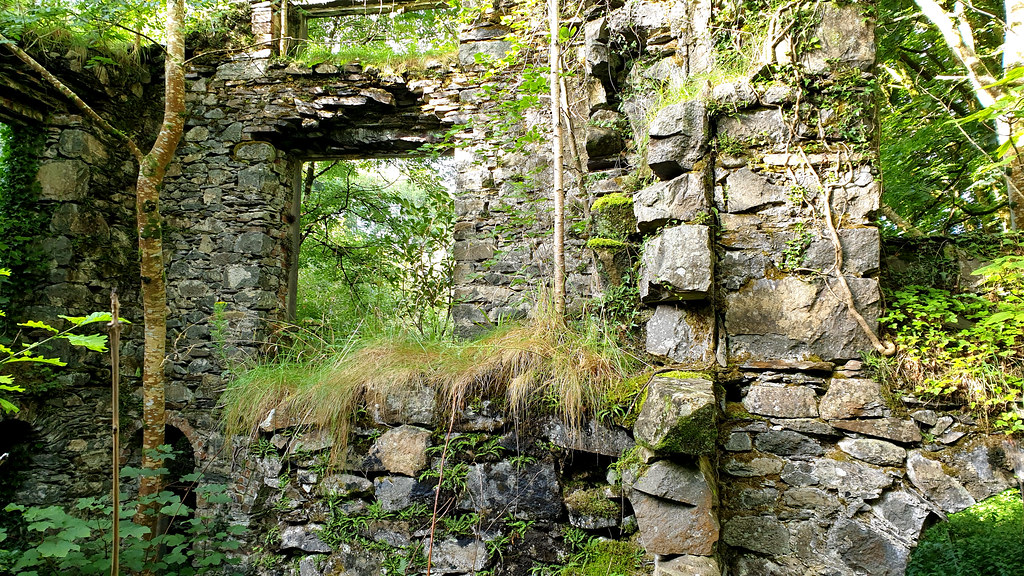 Bryncir 11 by HughieDW, on Flickr
Bryncir 11 by HughieDW, on Flickr
Looking out from the former porch:
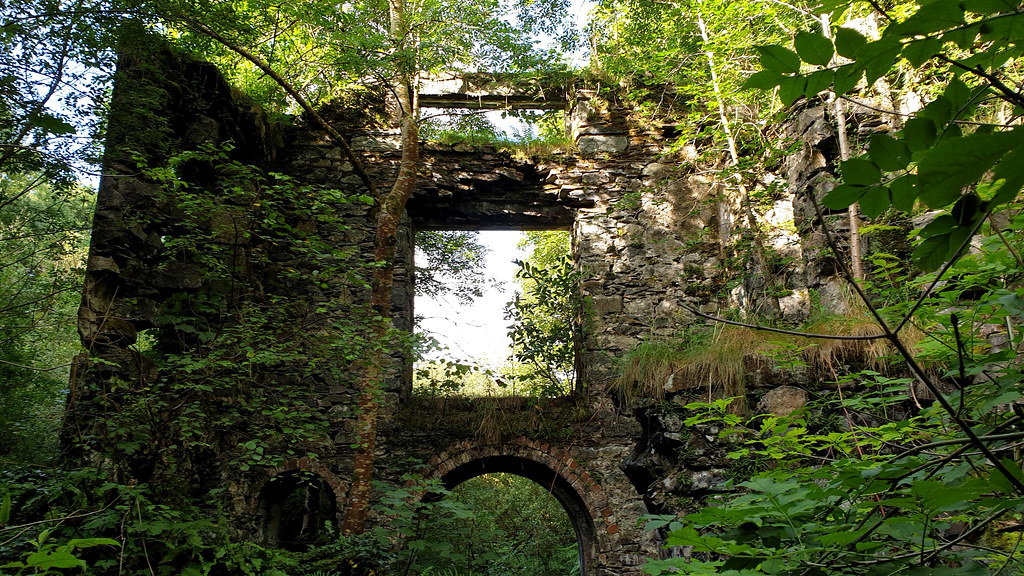 Bryncir 12 by HughieDW, on Flickr
Bryncir 12 by HughieDW, on Flickr
Wonder when the many of its large fireplaces, this one located on the second floor of the library, were last alight?
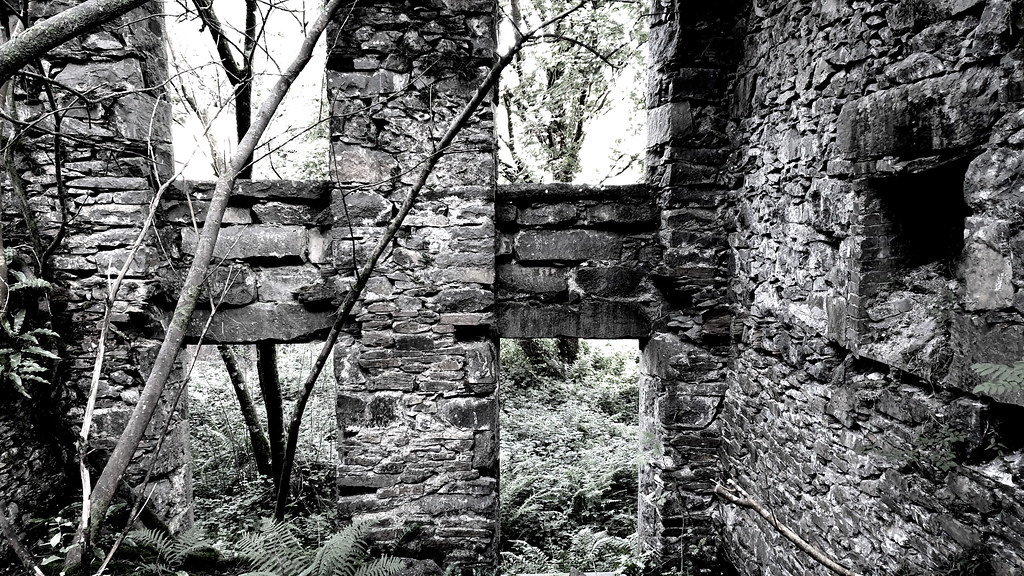 Bryncir 13bw by HughieDW, on Flickr
Bryncir 13bw by HughieDW, on Flickr
Really wanted to find these, the reminders that the hall was commandeered by the Ministry of Works as a POW Camp when fifty German Officers arrived in 1918. Theses bars are just to the north of the kitchen:
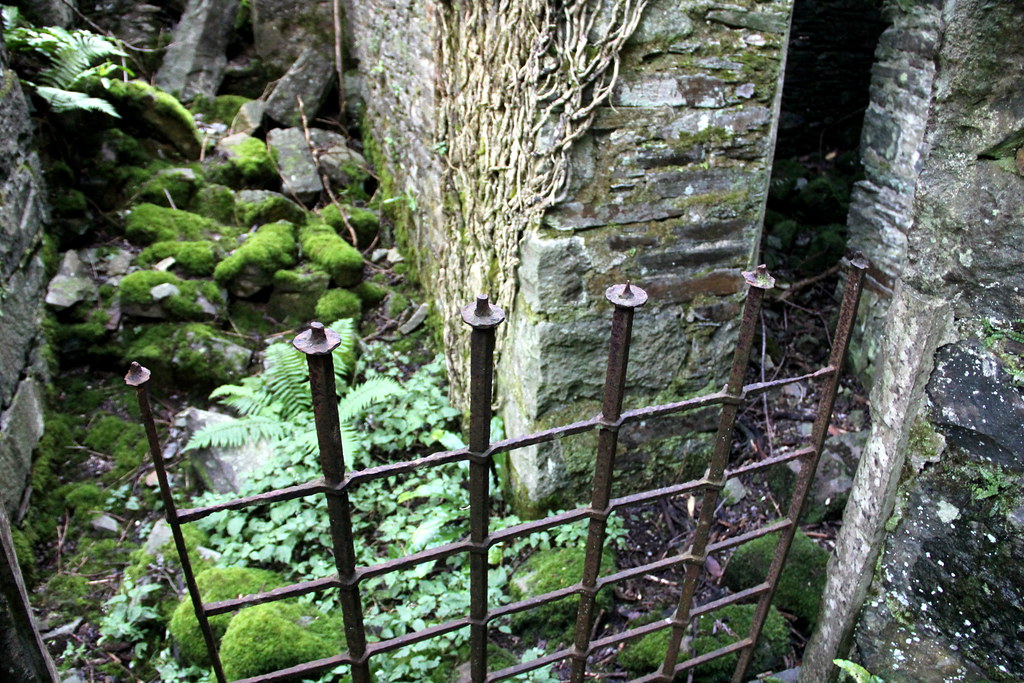 img7152 by HughieDW, on Flickr
img7152 by HughieDW, on Flickr
 img7153bw by HughieDW, on Flickr
img7153bw by HughieDW, on Flickr
And finally, the great fireplace in the hall’s kitchen:
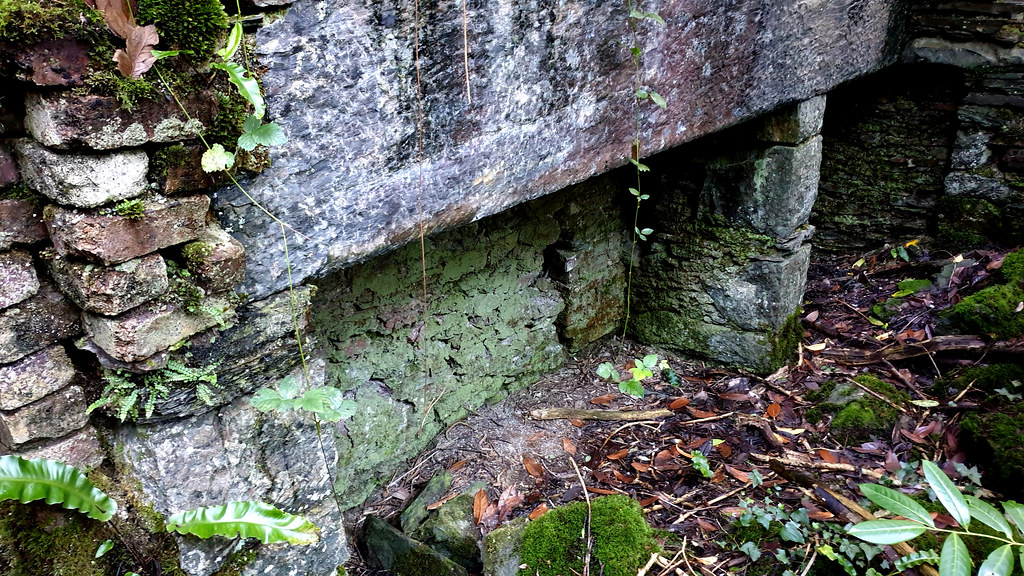 Bryncir 16bw by HughieDW, on Flickr
Bryncir 16bw by HughieDW, on Flickr
Brynkir Hall is located in the Cwm Pennant Valley, just North of Criccieth in North Wales. The origins of Brynkir can be traced all the way back to a thirteenth-century deer park, associated with the royal court or llys of Llywelyn the Great (1172-1240). The name ‘Brynkir’ itself is derived from Bryn Ceirw, meaning “hill of the deer”. It had previously appeared in documents and poetry in various other forms including Bryncir, Brynker, Bryncyr and Brynceirw.
The owners of the estate, the Brynkir family, had some interesting dynastic origins which can be traced all the way back to Owen Gwynedd. Building work started on the Brynkir estate in back in 1644 with the original hall, known as the “upper house”. It was built into the slope of a hillside, running parallel to the valley, so the gable ends faced the prevailing winds from Cwm Pennant. This afforded it strategic views over great distances while having protection from the elements. The house was much altered over the years and when the Brynker family died-out in the late 1700s, the estate was sold, the seventeenth-century additions to the hall removed circa 1800, and the upper house demoted to a farmhouse. Records indicate that the upper house continued in use into the mid-nineteenth century.
In the 1809, the 12,000-acre Brynkir Estate was bought by Captain Joseph Huddart (1741-1816). Huddart was a bit of a polymath: influential English Captain, hydrographer, chart-maker, inventor (including the steam-driven machinery for binding rope from which he made his fortune) and entrepreneur. He wanted to provide his family with a seat in north Wales and so went about using artisan craftsmen and a provincial architect to build a Regency villa. These are the ruins that remain today (sometimes referred to the ‘lower house’). The site was prepared for construction in late 1809 shortly after purchase and the walls raised in 1811. The first reference to the new house can be found in an estate account beginning in May 1812 and ends in December 1814. Here the records carefully detail all the purchases made as part of the house’s construction. Hence, we know by July 1812, the villa had been slated, and the interiors were in the process of being plastered. They also indicate that the house was likely to have been finished by December 1813. Surrounding the house were two serpentine walks through pleasure grounds, a small (now silted-up) lake and a large walled garden.
Sadly, after only seven years on the estate, Huddart died in 1816 and the estate passed to his son, also named Joseph. Born in 1767, he lived at the house with his wife and nine children between 1812 until his death in 1841. Sir Joseph held office as the high sheriff of Caernarfonshire, but also made his mark on the estate too. He oversaw the construction of one of the most interesting buildings on the estate: a six-story Gothic tower built on a nearby hill. In 1821 Joseph heard that the newly crowned monarch, George IV, was visiting North Wales. Prudently, he decided to celebrate the occasion by building the aforementioned folly. The tower was built using labour from ex-soldiers from the Napoleonic Wars who were part of a scheme to provide work for them. The tower certainly impressed as the king knighted Joseph Huddart during the visit.
The estate, in turn, then passed to his eldest surviving son, George Huddart (1822-1885). While his dad probably did the most work on the lower house, George made his mark by heightening the banqueting tower and possibly added a new frontage and entrance hall. He probably needed the room with his ten children! On his death, the eldest of his children, also named George Huddart (1845-1908), became the final Huddart to be lord of the manor. He commenced major building work on Brynkir in 1889, including the refurbishment of the interior and building a new porch and Billiard Room. This was incurred at significant cost (reportedly a sum of £8,000) and it nearly bankrupted the family.
Floor plan of Brynkir © Mark Baker
 20200409_131903 by HughieDW, on Flickr
20200409_131903 by HughieDW, on FlickrArtist’s impression of what the Brynkir would have looked like circa 1900 © Ceri Leeder.
 20200409_131942 by HughieDW, on Flickr
20200409_131942 by HughieDW, on FlickrA clue to how the hall came to be vacant is recorded in Sir Clough Williams-Ellis’s (the creator Portmeirion) autobiography. In it he refers to his Uncle Dick telling him that as a boy, he’d had gone up to Brynkir, only to find the place completely deserted with the table laid for breakfast but left with eggs half eaten and teacups half full. At first it was thought one of George’s sons had run off with the family governess and everyone had left the house in hot pursuit. More recently, it was speculated that George Huddart had a secret family and when it was discovered by his wife, Elinor, a furious row ensued resulting in the house emptying. The couple never divorced but George moved to London and his wife to Sussex. Whatever the reason, what is certain is that the estate was sold off in 1903. The estate was bought by the Greave family who used it as a hunting lodge until the start of the First World War. It was then commandeered by the Ministry of Works as a POW Camp for around fifty German Officers. In April 1930 the estate was broken up and sold off in lots. The hall again lay empty and after the second world war the house was partially demolished with the remains left to further fell into ruin. Records indicate the house was the sold on to local farmers who stripped of any reusable building materials (principally timbers and metals) in late 1945.
The house pictured in 1950 (©Mason, G. Bernard) looking like a ruin already:
 Bryncir old by HughieDW, on Flickr
Bryncir old by HughieDW, on FlickrSince then, Tower has fared much better than the house itself. For many years a shell of four walls, in the early 1990s the folly was full-renovated and now provides superior holiday home accommodation. The site of the halls have been the subject of a number of recent archaeological digs between 2012-14 which turned up remnants of a dinner service and wine bottles bearing the family crest and the name of the house.
Reference: information and some illustrations were sourced from Mark Baker’s excellent PhD thesis: The Development of the Welsh Country House: your court, the soul of the land’ (2015).
2. The Explore
Really emotional return to this place. One of the first places I explored as a child with my dad back in the day, so it has a really special place in my heart. Haven’t been here for over twenty years or so it was nice to see the place again and get some digital photos of the place. Situated at the head of the beautiful Cwm Pennant valley, this place isn’t visible from Google Earth and you need to know where the place is. This plus the fact that the ruins are a bit out of-the-way explains why this enchanting place gets very little traffic. Spent a very enjoyable early July morning navigating the foliage and scrambling over the stones to try and capture what is left of this once great welsh house.
The ruins are now really given over to nature. They’re not spectacular as say the better-known Baron Hill Mansion but what they lack in the wow factor they make up for in the atmospheric stakes. They are now really overgrown and although getting to them isn’t such an issue it is hard to physically get around them and as such, hard to photograph both from a perspective point of view and the light situation.
One thing I didn’t do was go up the nearby hill to look at the tower which has faired much better than the hall. This is now been fully refurbished and provides high-end holiday accommodation.
3. The Pictures
Having scrambled down the bank this is the first of many arched doorways I came to. This one is from the former billiards room:
 Bryncir 02 by HughieDW, on Flickr
Bryncir 02 by HughieDW, on Flickr Bryncir 03 by HughieDW, on Flickr
Bryncir 03 by HughieDW, on Flickr img7131 by HughieDW, on Flickr
img7131 by HughieDW, on Flickr Bryncir 05 by HughieDW, on Flickr
Bryncir 05 by HughieDW, on FlickrThis part, the front porch, almost maintains its original height:
 Bryncir 06 by HughieDW, on Flickr
Bryncir 06 by HughieDW, on Flickr img7132 by HughieDW, on Flickr
img7132 by HughieDW, on Flickr img7134 by HughieDW, on Flickr
img7134 by HughieDW, on Flickr Bryncir 07 by HughieDW, on Flickr
Bryncir 07 by HughieDW, on FlickrRound to the curved bays of the side of the house and the former drawing room:
 Bryncir 08 by HughieDW, on Flickr
Bryncir 08 by HughieDW, on Flickr img7137 by HughieDW, on Flickr
img7137 by HughieDW, on FlickrSome the building looks like bits will drop down at any minute:
 Bryncir 09 by HughieDW, on Flickr
Bryncir 09 by HughieDW, on FlickrInside it is completely overgrown:
 Bryncir 10 by HughieDW, on Flickr
Bryncir 10 by HughieDW, on Flickr Bryncir 11 by HughieDW, on Flickr
Bryncir 11 by HughieDW, on FlickrLooking out from the former porch:
 Bryncir 12 by HughieDW, on Flickr
Bryncir 12 by HughieDW, on FlickrWonder when the many of its large fireplaces, this one located on the second floor of the library, were last alight?
 Bryncir 13bw by HughieDW, on Flickr
Bryncir 13bw by HughieDW, on FlickrReally wanted to find these, the reminders that the hall was commandeered by the Ministry of Works as a POW Camp when fifty German Officers arrived in 1918. Theses bars are just to the north of the kitchen:
 img7152 by HughieDW, on Flickr
img7152 by HughieDW, on Flickr img7153bw by HughieDW, on Flickr
img7153bw by HughieDW, on FlickrAnd finally, the great fireplace in the hall’s kitchen:
 Bryncir 16bw by HughieDW, on Flickr
Bryncir 16bw by HughieDW, on Flickr
Last edited:



